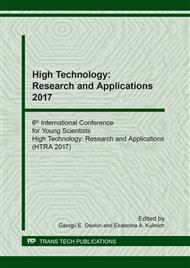[1]
V. A. Petrovsky, E. A. Vasil'ev, V. P. Lyutoev, V. I. Silaev, A. V. Kozlov, A. E. Sukharev, M. Martins, Characteristics of spectroscopy of the Brazilian diamonds, Mineralogical magazine. 1 (2011) 63-71.
Google Scholar
[2]
F. V. Kaminski, Superdeep diamonds from the Juina area, MatoGrossu, Contrib. Mineral. Petrol. 140 (2001) p.734.
DOI: 10.1007/s004100000221
Google Scholar
[3]
W. R. Taylor, J. J. Gurney, H. J. Milledge, Nitrogen aggregation character thermal history and stable isotope composition of some xenolith-derived diamonds from Roberts Victor and Finch, 6th Internat. Kimberlite Conf., ext. abstr, 1995, pp.620-622.
DOI: 10.29173/ikc1988
Google Scholar
[4]
W. R. Taylor, Nitrogen-defect aggregation characteristics of some Australasian diamonds: time-temperature constraints on the source regions of pipe and alluvial diamonds / W. R. Taylor, A. L. Jaques, M. Ridd // Am. Mineral. – 1990. – V. 75. – pp.1290-1310.
Google Scholar
[5]
E. A. Vasiliev, A. V. Kozlov, Y. V. Nefedov, V. A. Petrovsky, A comparative analysis of Anabar, Brazil and the Urals diamonds by method of infrared spectroscopy, The notes of the Mining Institute, T 200 (2013), 167-171.
Google Scholar
[6]
S. A. Grakhanov, V. I., Shatalov, V. A. Shtyrov, V. R. Kychkin, A. M. Suleymanov, Diamond placers of Russia, Novosibirsk: Publishing house Geo, (2007).
Google Scholar
[7]
Y. V. Nefedov, E. A. Vasiliev, A. V. Kozlov, V. A. Petrovskij, Structural features of Uralian, Anabar and Brazilian diamonds detected by FTIR, Scientific reports on resource issues, 2013, V. 1., pp.29-35.
Google Scholar
[8]
G. B. Bokii, G. N. Bezrukov, Y. A. Klyuev and others, Natural and synthetic diamonds, Moscow, Pub. House Nauka, (1986).
Google Scholar
[9]
Y. A. Klyuev, The Intensity of stripes in the IR spectrum of absorption of natural diamonds, Diamonds. No. 6 (1971) pp.9-12.
Google Scholar
[10]
S. R. Boyd, I. Kiflawi, G. S. Woods, Infrared absorption by the B nitrogen aggregate in diamond, Phil. Mag. B. V. 72 (1995) 351-361.
DOI: 10.1080/13642819508239089
Google Scholar
[11]
S. R. Boyd, I. Kiflawi, G. S. Woods, The relationship between infrared absorption and the A defect concentration in diamond, Phil. Mag. B. V.69 (1994) 1149-1153.
DOI: 10.1080/01418639408240185
Google Scholar
[12]
G.K. Khachatryan, An improved method of estimating concentrations of nitrogen in diamond and its application, Geological aspects of the mineral resource base of ALROSA,. Modern state and prospects of solution (2003) 319-322.
Google Scholar


